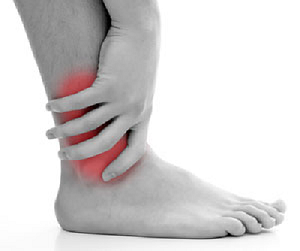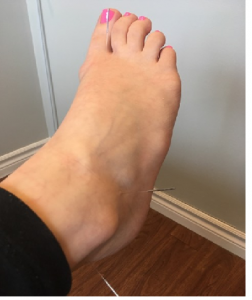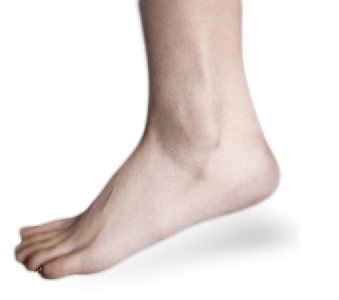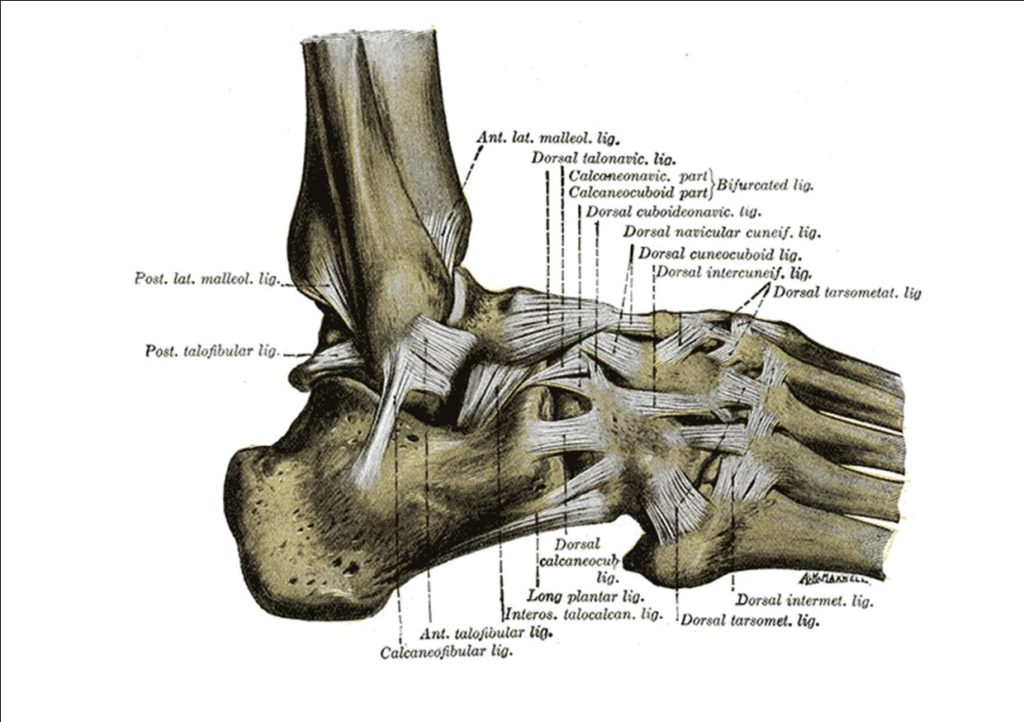What injury makes up 50% of all basketball injuries, 25% of all soccer and volleyball injuries and roughly 14% of all injuries seen in sports? The hint is, it’s the most common traumatic injury seen involving the lower extremity.

Answer: Lateral ankle sprains!
In this blog our Oakville physiotherapist at Glen Abbey Physiotherapy is going to help you understand what a lateral ankle sprain is, the severity and classification of ankle sprains, what your physiotherapist will do during your initial assessment and what you can expect from treatment at our Oakville physiotherapy clinic.
What Is An Ankle Sprain?
Ankle sprains can be defined as a sprain or rupture of some (or all) of the fibers of a ligament. An ankle sprain occurs when the ankle is forced beyond its normal physiological range resulting in ligamentous injury.
Most common ankle sprains and strains are lateral, meaning that they occur on the outside of your foot. This occurs when you roll your foot inwards. There are more ligaments on the inside of the ankle, and they are stronger than the ligaments on the outside. Spraining the outside of your foot is called an inversion sprain.
Imagine you are jumping to do a lay-up in basketball and when you land your foot accidentally rolls over your ankle on the outside or you step on someone else’s foot. These would be two examples of lateral ankle sprains. It is possible to roll your foot the opposite way, but it’s not as common! .
Now just because you’ve rolled your ankle does not mean you’ve had an ankle sprain. There are man different injuries and a diagnosis for ankle pain. Some examples include a fracture to the fifth toe, a stress fracture, dislocation of the subtalar or talonavicular joints, tendon injury of the Achilles or peroneal tendons (most common) or any other type of ligamentous injury. Visit our Oakville physiotherapy clinic to get the diagnosis and the treatment you need!
What Causes Ankle Sprains?
So what are some contributing factors in lateral ankle sprains? Previous ankle injury along the lateral side is a strong indicator that some of the tissues may have been under strain and therefore weakened or more lax from previous injuries. Footwear may also be a factor; being too narrow, too long, too unstable, poor support or simply lacking good tread to prevent a foot from rolling over.
A tight Achilles tendon is common during an adolescent growth spurt and therefore makes the ankle joint more prone to plantar flexion. Think about it this way, most lateral sprains occur when your foot is pointed down and rotated in. A tight Achilles prevents you from bringing your toes towards your nose therefore predisposing your ankle to be pointed downwards. The ankle is now subjected to half of the motion it needs to sprain laterally, thus being a large contributing factor for adolescents to sprain their ankle during sports or day-to-day activities.
Learn More About Ankle Sprains Here
When you are sprinting, stop quickly, roll your ankle and hear or feel a popping sound, what structure is actually being injured? The most frequently sprained ligament injured in a lateral ankle sprain seen here at Glen Abbey Physiotherapy in Oakville is known as the anterior talofibular ligament. ATFL for short! This ligament is on the front/lateral section of your foot. It attaches from one bone in the ankle, your talus, to that large outside bone of the ankle, your fibula. Thus the anterior talofibular ligament. This however is not the only lateral ligament your body has to support your ankle on the outside. There is also a calcaneofibular ligament, which resides just below that big bone on the outside of your ankle, and a posterior talofibular ligament, which is between that big outside bone and your heel on the back side of your ankle. Any one, two or three of these ligaments in any combination may be injured when an ankle is rolled. These ligaments are designed to prevent the amount of rotation shearing force that occurs on the lateral ankle, thus giving your ankle the support it needs so you can do the activities you like to do.
Grading An Ankle Sprain at our Oakville Clinic

When you twist or roll your ankle, there are three grades of injuries which may occur to the lateral ligaments. They are graded from 1 to 3 – with 1 being mild and 3 being severe.
Click Here To Learn More About The Grades of Ankle Sprains
Grade 1 Ankle Sprain
Grade 1 sprains that occur to the ATFL have suffered a mild stretch, no hemorrhage (bleeding) with minimal swelling and tenderness. These patients typically present with a minimal limp, difficulty hopping and recover in roughly 2-10 days.
Grade 2 Ankle Sprain
Grade 2 sprains are moderate in nature and cover a large range of injuries. For this reason, there are the most common grade we see in our physiotherapy clinic. Grade 2 sprains are associated with instability, complete tear of the ATFL with partial tear to the calcaneofibular ligament, some bleeding, localized swelling, limp, inability to toe raise/hop/run and recover in 10-30 days.
Grade 3 Ankle Sprain
Grade 3 sprains present with significant instability, complete tear of the ATFL, joint capsule and injury to associated lateral ligaments, diffuse swelling, very tender to touch, unable to fully weight bear through the foot and there will be significant pain. Recovery is expected within 30-90 days.
Remember, when you have a lateral ankle injury, these are not the only ligaments and structures, which may be injured. An individual may have a grade 2 ligament sprain but also a fracture of the fifth toe or a tendon strain with it. Therefore the active recovery time would not be 10-30 days but possibly months depended on the associated structures, which are injured along with the ligament. Visit with your physiotherapist at Glen Abbey Physiotherapy here in Oakville to have a thorough assessment of your ankle.
Ankle Sprain Treatment Oakville
So let’s say that you’ve injured your ankle and are seeking professional treatment for it – what will your physiotherapist do? We begin by doing a detailed assessment to find the root cause to your injury. Our physio team will inquire about the mechanism of injury, previous injuries, weight bearing status, swelling, popping or cracking sounds, your age, any of systemic disease, your symptoms, footwear, activity level amongst other details that help us begin zoning in on your ankle sprain.
From here we will perform a detailed assessment of the ankle to find out what the injury is. We will observe the area, watch you walk, squat, hop if possible, assess all the movements of the ankle both actively and passively, resist specific muscles which may be associated with the area of concern, mobilize your joints and assess their ranges of motion, perform special orthopedic tests to assess for end feels, laxity, spasm and pain of specific structures as well as perform other tests and palpation to fully understand any impairments to your lateral ankle. We may also ask to the patient to order an x-ray if we have suspicion of a fracture to the area.
Treatment for ankle sprains at our Oakville clinic depends on how severely the patient has sprained their ankle. Most ankle sprains will start with some hands on therapy along with Shockwave therapy. Shockwave is the gold standard for ankle sprains and aid in the healing process and help tissue heal faster. After the shockwave and mobilizations for the patients ankle the physio team will most likely run the IFC machine for 10 to 15 minutes with a heat pack to flush out all the fluid and damaged tissue. At home icing will be recommended. If a brace is needed, our Oakville physio team will most likely send the patient an Amazon link to the needed brace.
Click Here For Advanced Ankle Exercises
Acupuncture Treatment For An Ankle Sprain in Oakville
Acupuncture is an excellent treatment option for all stages of a sprained ankle recovery. Acupuncture treatment involves the insertion of needles through the skin at specific points to target nerves and/or muscles and affect their function. Dr. Jenn has has excellent success in speeding up the recovery process for ankle sprains treated with physiotherapy.
In the early stages of an ankle sprain, especially grade 2 and 3 sprains, acupuncture can be used to help control and reduce swelling. Swelling from an ankle sprain often drains down into the lower ankle and foot, and collects there. The swelling can restrict motion, cause footwear to feel too tight, and create a heavy and uncomfortable feeling in addition to the pain associated with an ankle sprain. In the initial stages of recovery, controlling swelling can significantly reduce pain and discomfort. The stimulation provided through acupuncture can make a noticeable difference, often after just a few treatments.
In the sub -acute stages of an ankle sprain rehabilitation, acupuncture can be used to directly stimulate the ligaments affected by the injury. The acupuncture needles have the unique ability to target the deeper structures of the ankle, and can reach places we have difficulty affecting with just our hands. There are a few specific points that have a great impact on the ankle joints and ligaments, and can significantly improve healing time.
-acute stages of an ankle sprain rehabilitation, acupuncture can be used to directly stimulate the ligaments affected by the injury. The acupuncture needles have the unique ability to target the deeper structures of the ankle, and can reach places we have difficulty affecting with just our hands. There are a few specific points that have a great impact on the ankle joints and ligaments, and can significantly improve healing time.
In the later stages of recovery, acupuncture can still be useful, especially when dealing with active people/athletes. Acupuncture stimulates the nerves and ensures optimal function of the muscles and other structures required to get back to physical activity. When an ankle/foot complex’s mobility has been limited by injury, sometimes it takes some time to get all aspects of the injured area functioning again. Acupuncture stimulates the nerves that control the injured area, and can wake up nerves that are used to being less active during the earlier stages of recovery.
Make sure to visit us here at Glen Abbey Physiotherapy where our team and staff can help you on your way to recovery after a lateral ankle sprain. Remember to always be assessed when having an injury so there is a diagnosis and active treatment plan in place to help you get back to the activities you love.

